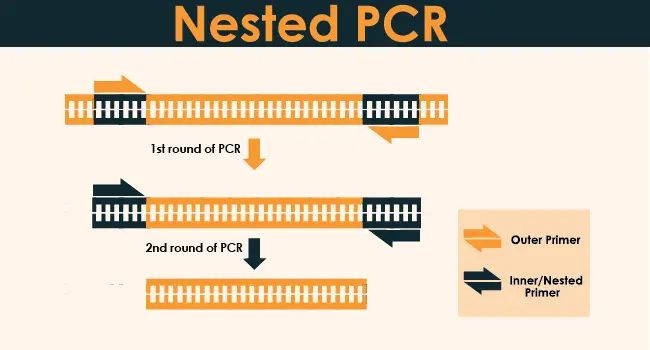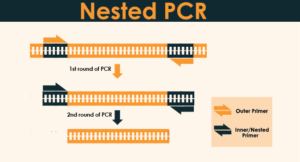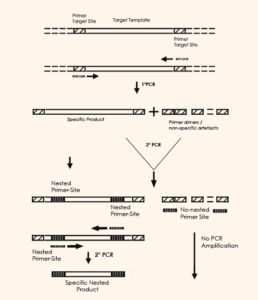
What is Nested PCR | Principle | Applications | Advantages and Dsadvantages
Nested PCR includes 2 sets of primers used to amplify a specific DNA fragment. The 1st primer-pair amplifies fragment as the standard PCR do WHILE the 2nd pair of primer byte within the first PCR product. The 1st primers-set can also be known as outer-primers and the 2nd one is also known as inner/nested primers.

Traditionally this type of Polymerase Chain Reaction (nested) approach was to perform number of PCR loops by using the first set of primers (outer-primers) and then open the vessel carrying reaction and add the second set of primers (inner/nested primer) to run the second cycle of PCR.
While this PCR the biggest problem arises in labs in the contamination of the amplicon and the loss of specificity as a result. To tackle this problem single-tube nested Polymerase Chain Reactions have been introduced. This includes the both types of primers initially added to the reaction vessel and extended PCR is performed.
If we electrophorese the reaction mixture in 2% of ethidium bromide-stained agarose gel along with a molecular weight marker we can visualize the amplicons from this type of PCR.

Nested PCRs are some of the time important to make up for in-efficient first-round nested approach due to the primer mismatches so, if we consider firm-matched primers for first-round, PCR approach may not required in many circumstances anymore.
Application of nested PCR
Nested PCR applications reveals that It is an extremely important and worthy process used from long time in pathology labs for microorganism detection as:
- For the detection of Bartonella, Rickettsia, and many organisms in tissues and blood (bacteremia).
- For the detection of enterovirus and herpesvirus in the CSF ( Cerebrospinal Fluid).
- For the detection of M.Tuberculosis in a sputum sample.
Nested PCR advantages and disadvantages
Advantages of Nested PCR:
- The very central advantage in the nested pcr advantages is that this process present 100% specific and accurate result.
- It makes it even possible for the impossible DNA templates where the GC (Guanine, Cytosine) may be high, the nested PCR presents the best results.
- For gene amplification, it is a useful process with minimal abundance.
- It is the best choice to study viral infections and carcinoma.
- In the phylogenetic analysis and genetic polymorphism, it is still a useful and benficiary process to sonsider.
- It is also a useful process in reducing the non-specific amplification of the sequence of interest.
Disadvantages of Nested PCR
Nested PCR Disadvantages are as follow:
- It is considered a quite time-consuming process.
- The risks of contamination during the performance of this process are high.
- It is a quite costly method as it needs more reagents like extra primer-set and extra rounds of agarose gel electrophoresis.
Nested PCR Primers
Nested PCR includes 2 primer groups that are considered in 2 consecutive PCR cycles. the 2nd set aimed to purify the 1st cycle outcome within the secondary target. This permits littler number purification restricting the nonparticular outcomes.
The 2nd primer group should solely purify the aimed outcome from the 1st purification cycle and not the non-particular outcome. This permits directing further rounds along reducing non-particular outcomes. This is valuable for uncommon PCR templates with lofty foundations.
The target DNA experiences the primary run of polymerase chain response with the primary group of primers. The determination of elective & comparable primer conjunctional sections delivers a outcome determination, solely possessing the aimed sequences.
the first cycle outcome experiences a 2nd round along with the 2nd primer group. It is exceptionally impossible that any of the undesirable PCR items contain authoritative locales for both new primers, guaranteeing the outcome from 2nd PCR has small defilement from undesirable outcomes of clips, elective primers target sequences, and primer dimers.
Nested PCR Principle
Nested PCR is a bi-step (2 steps) procedure with an initial purification cycle along with the external onward & inverse primers. The protocol is described as below:
| Constituents | Quantity | Concentration |
| DNA temp | 3µL | 30 nanogram |
| Water | 3µL | Distilled |
| MasterMix | 12µL | 1x |
| External Reverse Primer | 1µL | 10pM |
| External Forward Primer | 1µL | 10pM |
| Sum | 25µL | |
| Then.. |
| Steps | Commencing Denaturation | Denaturation | Annealing | Extension | Concluding extension |
| Temperature | 90-95 degrees | 90-95 degrees | 55-60 degrees | 72 degrees | 72 degrees |
| Time | 3 minutes | 1 minue | 50 seconds | 1 minute | 7 minutes |
Post completion of the primary purification cycle, take the tubes and plan the response for the 2nd cycle purification.
Now include 1µL inner reverse and forward primer to PCR tubes of the initial purification cycle.
| Constituents | Quantity | Concentration |
| Reaction Buffer | 5µL | 1x |
| MasterMix | 12µL | 1x |
| Internal Reverse Primer | 1µL | 10pM |
| Internal Forward Primer | 1µL | 10pM |
| Initial PCR amplicon (DNA temp) | 3µL | |
| Total | 25µL | |
By putting in back into the machine..
| Steps | Commencing Denaturation | Denaturation | Annealing | Extension | Concluding Extension |
| Temperature | 90-95 degrees | 90-95 degrees | 50-60 degrees | 72 degrees | 72 degrees |
| Time | 3 minutes | 1 minute | 50 seconds | 1 minute | 7 minutes |
| 35 rounds |
Rather of 35 PCR runs, set 25 runs. Higher enhancement is accomplished by expanding runs within the 2nd PCR run. More amplification of interest sequence can be done.
Nested PCR in Microbial Determination
Nested PCR delivers are incredible vitality to the technique that can be worth procedure to pathogen detection and phylogenetic examination.
The strategy has higher touchy thus indeed in case the test contains lower DNA, it can increase, which isn’t conceivable by the routine PCR strategy. In expansion to this, the strategy is profoundly particular. Within the nested PCR, the widespread primers for 16S &18S rRNA are utilized as an external primer.
The second pCR cycle target centric PCR technique can be applicable.
One of grouping primers are particular to sole pathogen intensifies DNA layout in the event that the target arrangement is display.
Once the intensification is accomplished, the sum of pathogen show within the test is calculated quantitatively-ultimately the species of the pathogen can be figured out.
Conclusion:
In spite of the fact that the nested PCR is the most known excellent choice for accomplishing the specificity, it devours more time. It is limited, the method isn’t appropriate for long-range PCR. It is considered as a goal standard technique that is utilized for pathogen detections.